yeovil & district co-operative society
yeovil & dist. co-operative society
Founded in 1889
A co-operative society is an association of voluntary members for a common purpose and mutual benefit such as the provision of retail, industrial, commercial or agricultural services. The control of the society is democratic since members share equally in the risks and the responsibilities and resultant profits are distributed in proportion to the business which each member undertakes through the society.
However, there were at least two earlier societies in Yeovil based on the Co-operative Society lines; the Yeovil Industrial Provident Society (see below) and the Yeovil Temperance and General Co-operative Society Limited that was created in 1875, some fourteen years before the Yeovil and District Co-operative Society was founded.
Yeovil Industrial Provident Society
The Yeovil Industrial Provident Society was an early society in Yeovil based along similar lines to the Co-operative Societies. The society began in 1860 but only lasted until 1868. In 1860 it produced a 16-page rulebook entitled "Rules of the Yeovil Industrial Provident Society", published by the Western Flying Post office. The society issue £1 shares to a maximum of one hundred, and arranged loans from £5 and upwards at 6% per annum.
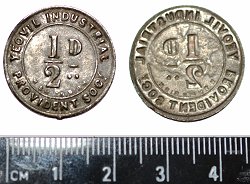 |
The rare ½d dividend check or token in my collection, shown at left, was issued by the society and the short life of the society dates the token with some accuracy. The token is 22mm in diameter, 0.75mm thick and made of stamped, tinned iron. |
See also Yeovil Trade Tokens and Checks
In December 1861 the Sherborne Mercury reported ".... the one great object (of the society) is to induce operatives to deposit money, which they may draw when necessary, in the shape of unadulterated food. When we italicise the word 'unadulterated' we by no means intend to cast a reflexion upon the character of our tradesmen; but that an immense amount of adulterated food is consumed by the public, and especially the poor, is a matter of notoriety."
Whereas most of the early friendly societies only operated with cash handouts to members, it appears that the Yeovil Industrial Provident Society actually had its own store for members along the lines of the Co-operative movement. The following report is from the 15 April 1862 edition of the Sherborne Mercury "The first quarterly report of this society has just been published. The cash account shows that the receipts during the past quarter for goods sold at the stores amounted to £207 5s 6d (around £17,000 at today's value). There are in the bankers hands £31 19s 9d; in the hands of the treasurer £2 12s 4½d, and the storekeeper has a balance of 5s 6d. The stock in trade is estimated at £108 1s 9d and the fixed stock at £3 15s, which gives the amount of assets at £146 14s 4½d. The liabilities are - members' claims as per ledger £130 6s 6d, and interest on paid up capital at £1 2s 11d, which gives a clear profit on the quarter of £15 4s 11½d. The Society has only recently been established, but it appears to be in flourishing condition."
In April 1863 the Western Gazette reported "The advantages enjoyed by members are... threefold, first, they get better interest for their money than they could obtain at a savings bank; secondly, they are secured against adulteration; thirdly, they get a pound's worth of goods for 18s 6d. The committee has decided on supplying each member with 'The Co-operator' - the organ of the co-operative movement - monthly, at the Society's expense. We understand that the Society has purchased more eligible premises than those they now occupy, and that, in a few months, it will make its appearance in Middle Street."
Sadly, the society was not to endure....
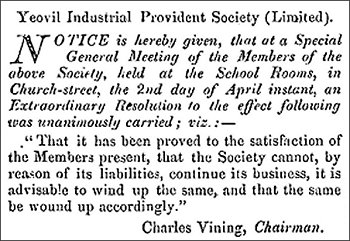
This notice, winding up the society, was placed in the 14 April 1868 edition of the London Gazette, the society's freehold premises in Middle Street having been sold by auction on 15 January 1868 at the Castle Inn.
![]()
The Co-operative Movement blossomed in the latter part of the eighteenth century but it was not until the spring of 1889 when a poster was pasted onto a hoarding, on the corner of South Street and Stars Lane, that the movement came to Yeovil. The poster announced a meeting that was to be held in the Town Hall where the advantages and benefits of such a Co-operative Society would be explained to the people of Yeovil.
The meeting was duly held and led by members of the Gloucester, Plymouth and Bristol Societies who put the case for the creation of a Co-operative Society in Yeovil. Such was the success of their persuasiveness that a Committee was formed of ten Yeovil men with Tom Foyle elected as Chairman and George Clapshaw as Secretary.
The Yeovil & District Co-operative Society was registered under the Industrial and Provident Societies Act 1876 on 22 June 1889. Following this a further meeting was held at which fifty members to the new Society were enrolled.
In any event, premises for a Co-operative Society grocery were found at a shop in Middle Street which was rented at £65 a year plus rates and taxes. The first manager, George Pickersgill, was engaged at a weekly wage of £1 7s 0d plus 1¼% of the profits and accommodation over the shop. The Society's first shop opened for trade on 27 July 1889. There were now a total of 80 members who had together invested £130. The committee had envisaged net sales of £50 per week however it quickly became apparent that this was not to be achieved. George Pickersgill was given a month's notice and John Childs was invited in as the new manager. Childs however found the job not to his taste and handed his notice in within a matter of weeks. A Members' meeting was held in November 1889 at which George Clapshaw was elected President of the Society and William Pardy Ewens (younger brother of glove manufacturers Frederick Ewens and Edward Ewens) was appointed Secretary on a salary of £10 per annum.
In 1890 the society started a bakery, employing William Gibson as baker at a salary of £1 per week plus a quartern (4-pound in weight) loaf each day. In 1892 the Society moved premises further down Middle Street with a new improved bakery. However in 1894 Mr Connock, who owned the triangular block of properties from Turnstile Lane eastwards, was retiring. His properties included three cottages and a corner house and shop facing Middle Street, three facing Turnstile Lane and two facing South Street. The Middle Street shop including an oven and bakehouse, flour loft and stables. The Co-operative Society purchased the properties from Mr Connock for £1,250. The purchase had the effect of bringing the Society to the attention of the people of Yeovil and membership and share capital, as well as trade, increased dramatically. The discount allowed to the Society's members increased to 1s in the pound on groceries and 1s 6d in the pound on bread. By the end of the year membership stood at 389 with a share capital of £946 and the years trading figure stood at £4,621 (approximately £1.8 million at today's value). It was decided to increase Members' discount on bread to 2s in the pound and 2½% of net profits was allocated for the use of the newly-formed Educational Committee.
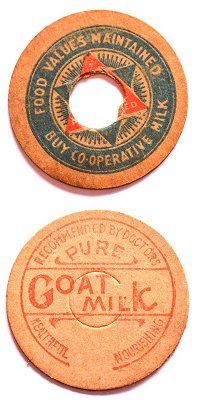 At
left are two
early twentieth
century
Co-operative
Society milk
bottle tops in
my collection,
one for ordinary
cow's milk and
the other for
goat milk. At
the time milk
bottles were
made with a wide
mouth at the top
of the bottle
and were sealed
with these waxed
cardboard discs
and usually in
the centre was a
dotted ring
where you could
push your finger
through to lift
off the disc and
pour out your
milk.
At
left are two
early twentieth
century
Co-operative
Society milk
bottle tops in
my collection,
one for ordinary
cow's milk and
the other for
goat milk. At
the time milk
bottles were
made with a wide
mouth at the top
of the bottle
and were sealed
with these waxed
cardboard discs
and usually in
the centre was a
dotted ring
where you could
push your finger
through to lift
off the disc and
pour out your
milk.
The Society was first recorded in local trade directories as a grocer of Middle Street in Whitby's 1895 Yeovil Almanack Advertiser. The first branch outlet, opened in 1897, was in purpose-built premises in Orchard Street that had its own shop with a commercial bakery, granary, stables and coach house to the rear of the property. The manager was Walter Thorne.
In 1899 the Society opened a Savings Bank for Members under the auspices of the Educational Committee and in the same year occupied part of the premises they had purchased between Turnstile Lane, South Street and Middle Street. This year also saw the opening of another new branch, this time in Lyde Lane, and Walter Thorne was transferred from Huish to manage the new shop.
New premises were built at this location, occupying the whole of the junction facing the Triangle, which opened in 1910 as retail space and offices above - the whole of which was occupied by the Society.
By 1939 membership of the Society was in excess of 9,000 with annual sales totalling some £202,000 (around £29 million at today's value) and had a myriad of branches as seen in the advertisement below, including branches in Sherborne, Milborne Port, Somerton and Langport.
The Co-operative movement stalled after the Second World War and by the 1970s many of the stores had been sold off, including the main store in the Triangle which closed in 1958. Today Yeovil has just a Co-op convenience store in Stiby Road and the recently-converted Fleur de Lys on the junction of St Michael's Avenue and Mudford Road.
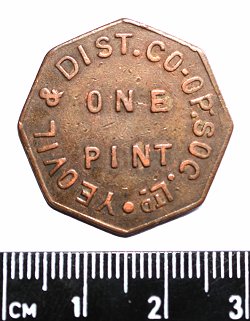 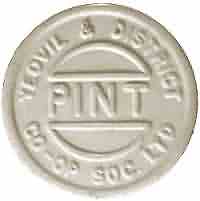 |
A bronze commodity token, from my collection, issued by the Yeovil & District Co-operative Society for a pint of milk. This type of token started to come into use after the First World War. They could be purchased at the local co-op as required, or in bulk and the value credited to your dividend account. The tokens could be left out or given to the delivery man meaning deliveries were speeded up as no cash was involved or change given. This token is 27mm point-to-point, 25.3mm flat-to-flat. Obverse and reverse are identical. An oval bronze token for a half pint of milk is also known. When the price of the commodity was altered a token of a different shape or different colour was usually issued to denote this, especially with the later Yeovil plastic tokens of the 1950s / 60s which are known in cream (as this example), green, yellow, deep turquoise and red. These plastic tokens are 25mm in diameter and 1.75mm thick.
|
|
See also Yeovil Trade Tokens and Checks
gallery
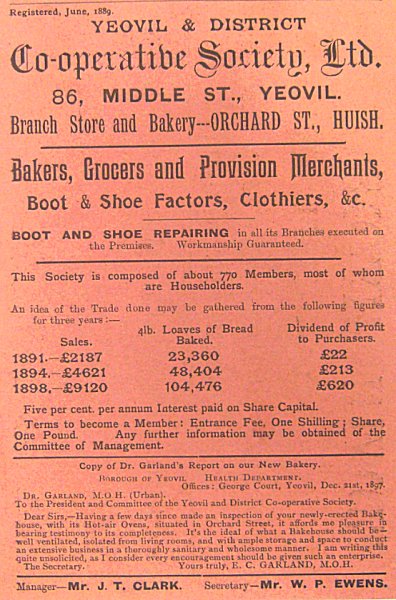
An advertisement for the Yeovil & District Co-operative Society. This appeared in Whitby's Yeovil Almanack Advertiser of 1900. 104,476 4lb loaves of bread, known as quarterns, is an awful lot of bread working out to about 10.4lb of bread per member per week.
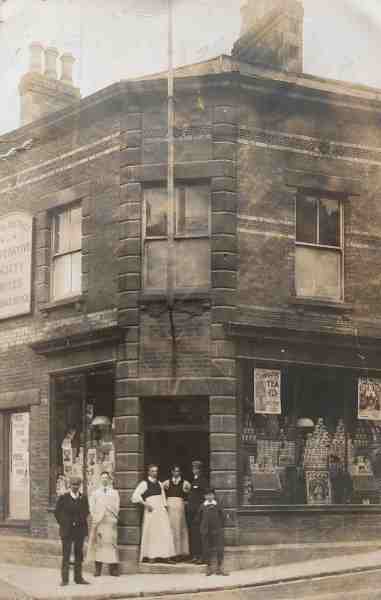
Courtesy of
Lynne & Tony
Cove
Photographed on 28 May 1908, this building is the precursor to today's building in the Triangle that was most recently the Turkish restaurant. It was on the corner of Middle Street (running off to the right in this photo) and Turnstile Lane (running off to the left). The triangle of buildings on the eastern side of Turnstile Lane, opposite this building, were torn down around 1900 to create today's open space known as the Triangle. The man In the middle of the three standing in the doorway is Dennis Moore.
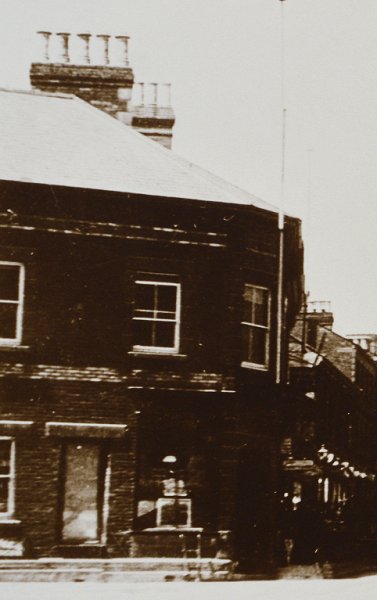
From my
collection
This building was originally it was on the northwest corner of Turnstile Lane. The eastern side of Turnstile Lane was demolished between 1886 and 1901, while this building was occupied by the Yeovil & District Co-operative Society and later replaced by their new shop and offices building (that survives today and appears in most of the images below) by 1913.
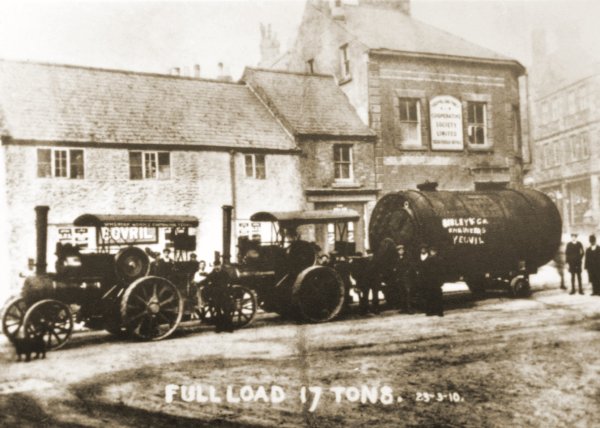
Courtesy of Jack
Sweet -
This photograph
features in my
book 'Yeovil
From Old
Photographs'
The buildings that were originally the west side of Turnstile Lane photographed on 23 March 1910. By this time occupied by the Yeovil & District Co-operative Society. The double tractor unit pulling the 17-ton load was owned by Sibley & Co.
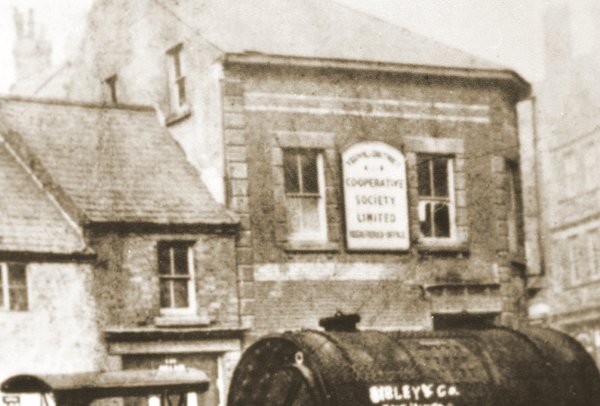
Courtesy of Jack
Sweet
An enlargement of the previous photograph showing the signage of the Yeovil & District Co-operative Society.
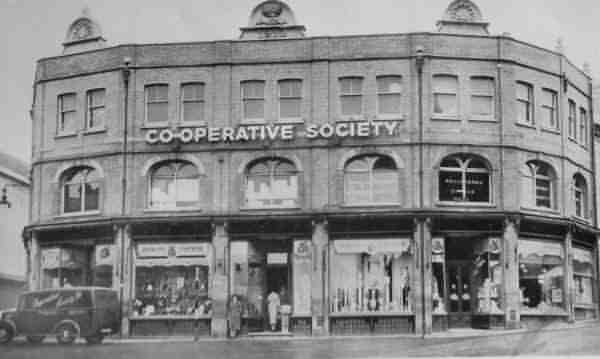
The new Co-operative society's main outlet and offices in the Triangle, photographed in 1939.
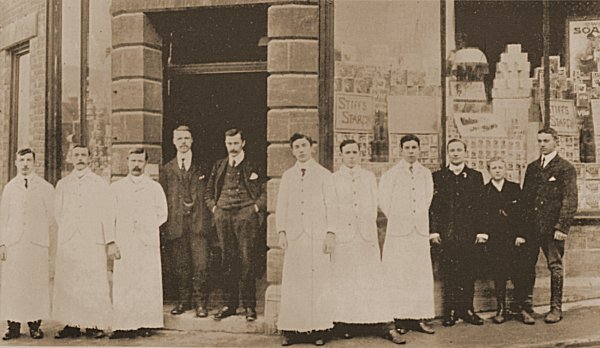
Staff pose for a group photograph outside the premises in the Triangle in 1906 in front of the new premises, occupying the whole of the corner between South Street and Middle Street and seen in most of the following photographs.
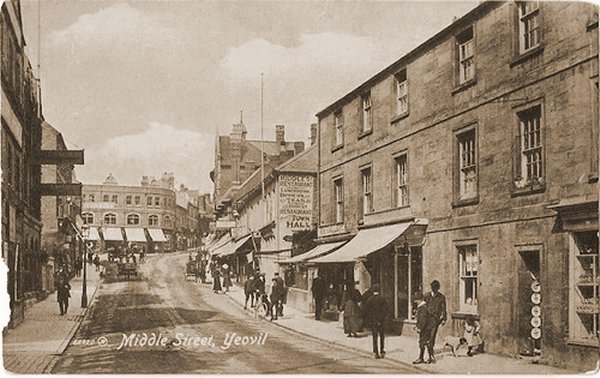
A postcard of around 1912 of Lower Middle Street looking towards the Triangle with the new Yeovil & District Co-operative Society building built in 1910.
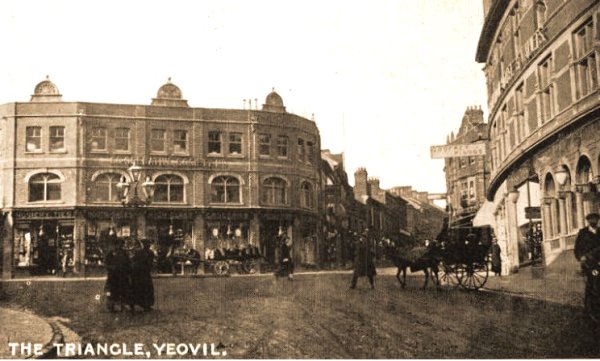
This postcard also dates to 1912 and shows the area of the Triangle completely free of obstructions and dominated by the new Co-operative building centre and left, with the Coronation Hotel at right. Note the three-lantern Sugg lamp to the left.
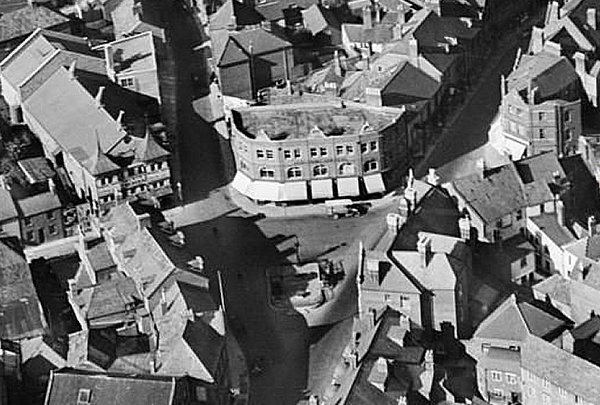
A 1928 aerial view of the Triangle with the Yeovil & District Co-operative Society building at dead centre. At far left is Stars Lane with the old Palace Theatre (Yeovil's first cinema). Running to the top of the picture at left is South Street and running to top right is Middle Street with the entrance to Vicarage Street at centre left. In the centre of the Triangle are the famous underground toilets.
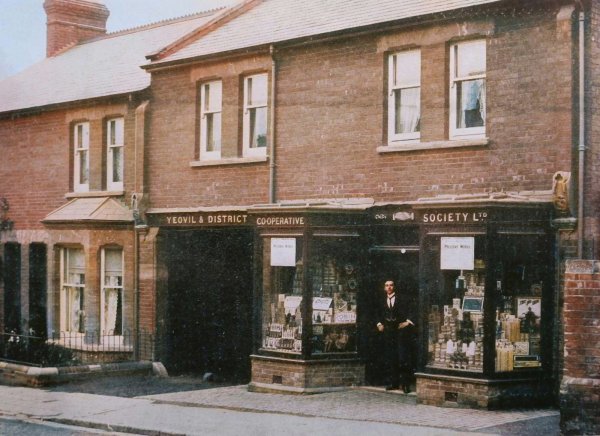
This colourised photograph
features in my
book 'Yeovil
From Old
Photographs'
This was the Society's first branch outlet which opened in 1897 in Orchard Street. The archway led through to its own bakery and stables at the rear of the premises. The manager was Walter Thorne. The building has recently been converted to residential properties (see Orchard Street).
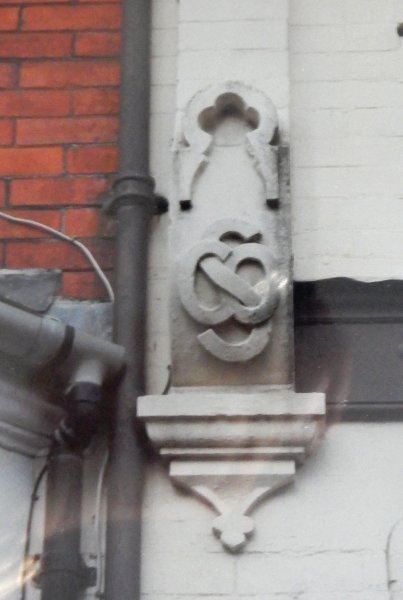
Photo by Jack
Sweet. Courtesy of South Somerset Heritage Collection
The Co-Operative Society logo remains today on the left of the port-cochere seen in the previous photo. Today the logo is painted black. Photographed in 1993.
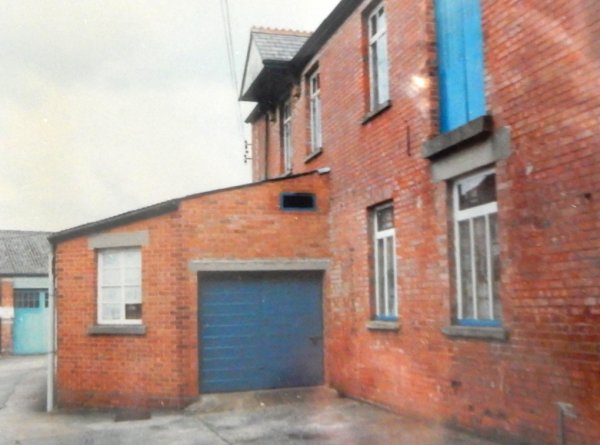
Photo by Jack
Sweet. Courtesy of South Somerset Heritage Collection
The Co-Operative Society bakery building in Orchard Street. Photographed in 1993.
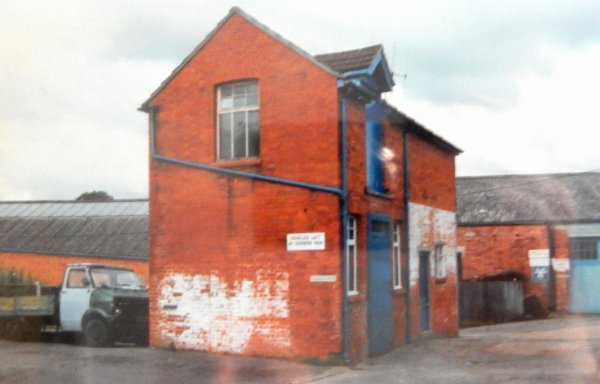
Photo by Jack
Sweet. Courtesy of South Somerset Heritage Collection
The Co-Operative Society bakery stables. Photographed in 1993.
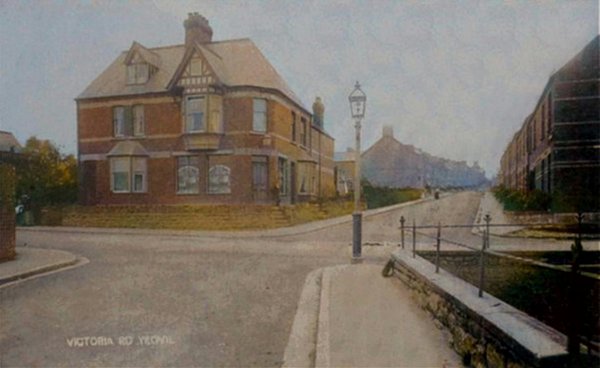
This
colourised
postcard
features in my
book 'Yeovil
- The Postcard
Collection'.
A 1904 postcard of Victoria Road, seen from Camborne Grove with Lyde Road running across the photograph. The corner shop, first opened in 1899, was the second branch outlet of the Yeovil & District Co-operative Soc Ltd, The shop is now a private residence (see Victoria Road).
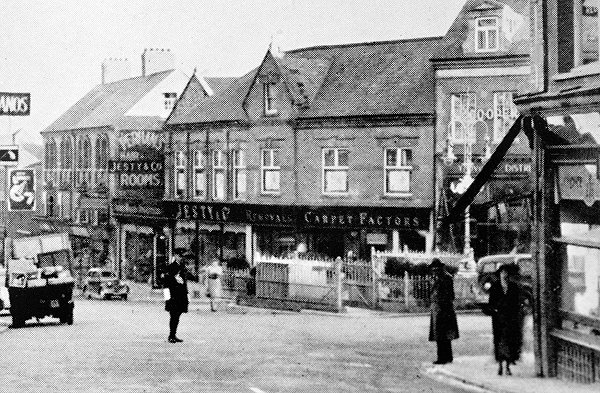
Courtesy of Jack
Sweet
The Triangle photographed in the early 1950s. By this time Thomas Jesty had sold off the right-hand part of his premises which was now occupied by the Yeovil & District Co-operative Society. Within a couple of years Jesty's had closed and the Co-op occupied all the former Jesty premises.
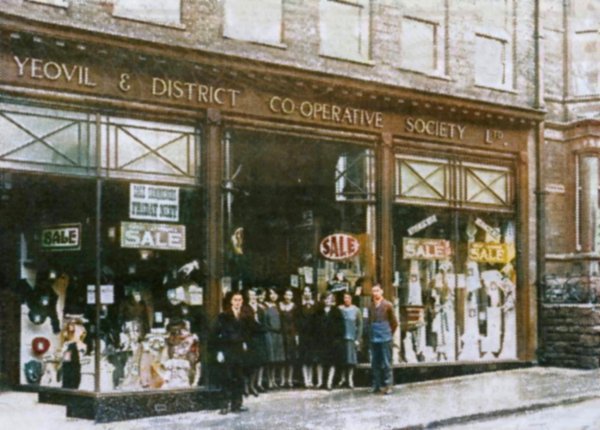
Courtesy of Alan
Jackson
This colourised photo of the staff of the Co-op in the former Jesty's premises is thought to date from the late 1950s.

Looking down Lower Middle Street, remarkably traffic-free around 1960. At right is the Yeovil & District Co-operative Society's furniture branch store which had originally been Thomas Jesty's furniture emporium.. At the far end is the office building of the Town Gas Works.
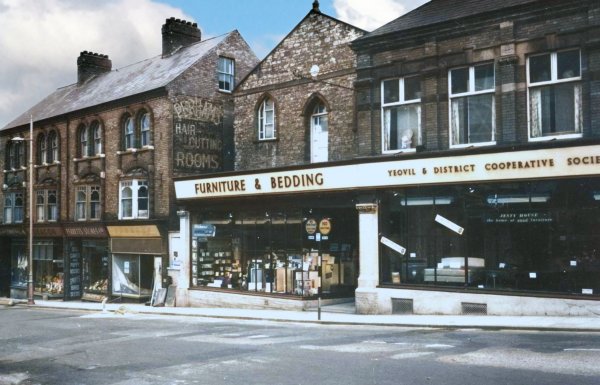
From the Cave
Collection
(colourised),
Courtesy of South Somerset Heritage Collection
This photograph
features in my
book 'Yeovil
From Old
Photographs'
A more direct view, with the old Methodist chapel at centre. This was all demolished around 1980 and the site is now occupied by Poundland.
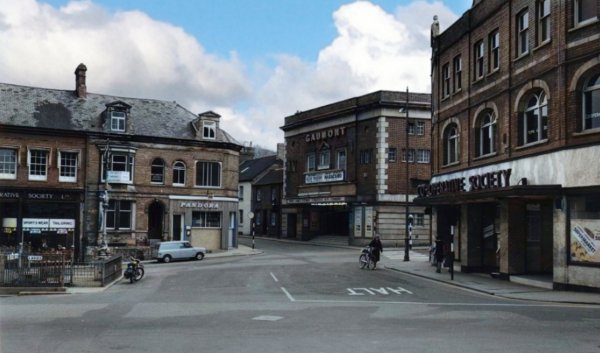
From the Cave
collection (colourised). Courtesy of South Somerset Heritage Collection
The Triangle, photographed in 1958. By this time the Co-op had closed this store and moved to its new supermarket at 47 Middle Street.
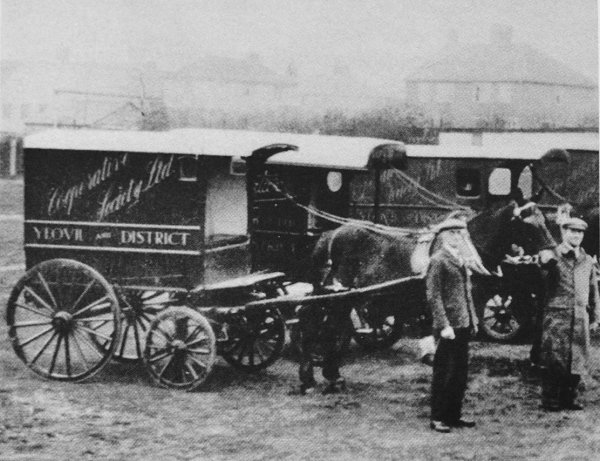
The Society's horse-drawn bread delivery vans of the 1900s through 1930s.

This colourised photograph was taken in 1939 as part of the jubilee celebrations of the Yeovil and District Co-operative Society and their fleet of vans are lined up on Fairground Field in Huish. The large building at right is the rear of Huish County Junior School, which is itself masking the view of Yeovil Town Football Ground with its famous sloping pitch. Queen Street is seen between the two-storey buildings to the left of the photograph with the Victoria Inn on the left corner, facing Huish.
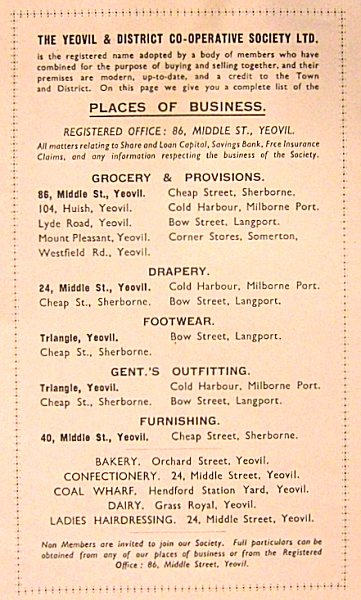
An advertisement of 1939 listing all the branches of the Society.
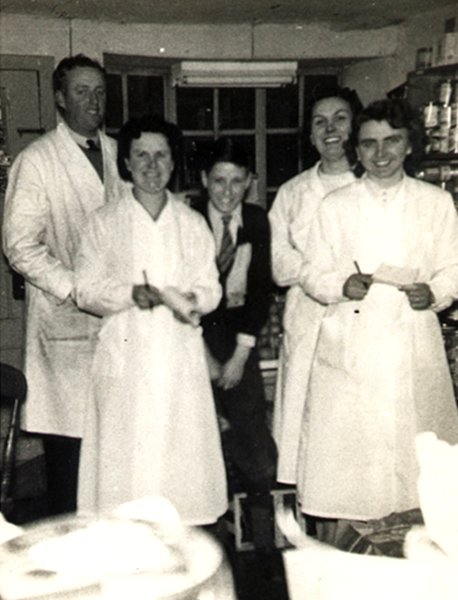
Courtesy of
David Collard
A staff photo, probably taken at one of the Co-op's branch stores. David's father, Edward Collard, stands at the back on the left.
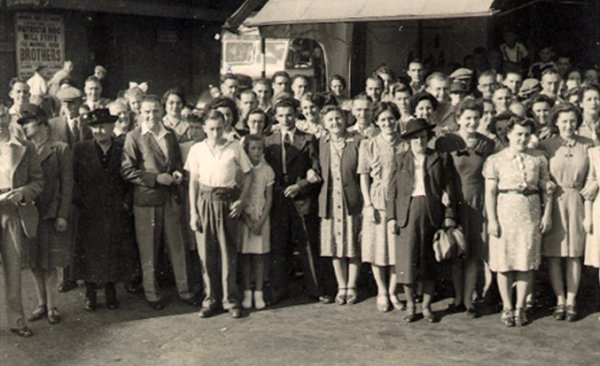
Courtesy of
David Collard
A photograph by Walter S Rendell & Son, probably taken in the early 1950s, of Co-opertaive staff and their families gathered outside the Co-operative premises in the Triangle in preparation for a staff day's outing.
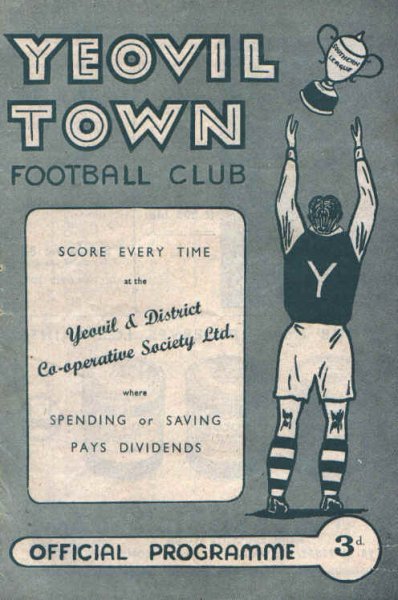
In 1958 a peculiar dual league structure led to a change in Yeovil Town Football Club's programme design. To save the trouble and cost of having to print different covers the club simply removed all reference to the match and competition being played from the front of the programme, replacing this information with an advert for the Yeovil and District Co-operative Society Ltd.
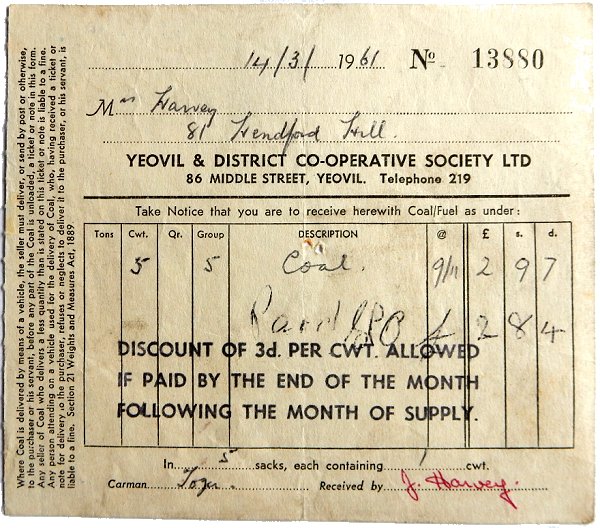
From my
collection
The Co-op even delivered coal - a receipt dated 14 March 1961 for five sacks of coal.
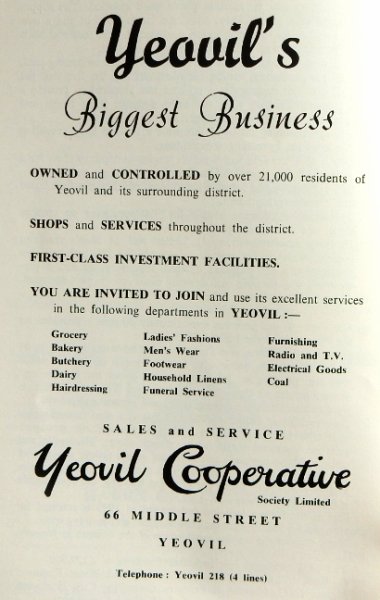
The Co-op's advertisement in the 1962 Yeovil Guide illustrating the range of goods and services offered.